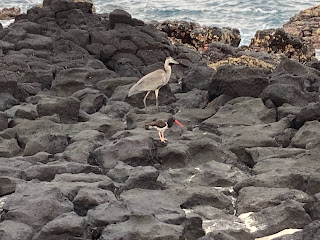Once again, Quito was cool, cloudy, and rainy. We left it behind to head for the airport, but we were delayed by a major traffic accident that had traffic backed across three lanes for well over a mile. Fortunately, Juan had allowed for such an eventuality, so we arrived at the airport in plenty of time.
Getting to the Galapagos involves some extra steps at the airport. First we had to line up for Covid screening. Nothing was computerized. The women inspecting our passport, vaccination card, and PCR test result document sat with clip boards and wrote everything down by hand — name, passport number, test date, etc.
There was also a special luggage screening to make sure we weren’t bringing any fresh fruit, seeds, plants, pets, or other agricultural goods to the Islands.
We have noticed that Ecuadorians apparently use middle names rather than first names. Our passports have all three names, so that is how the travel company registered us with the hotel, the airlines, etc. So we got through the airport and onto our boat as David and Katherine. Everything is marked that way, and it took us a while to figure out who those people were.
Another odd thing was the seat assignments on the plane. One of us was assigned seat 9D and the other to seat 9K, but we were right next to each other. No indication of what happened to seats E,F,G,H,I, or J. Fortunately, the plane was not very full, so we had the entire row to ourselves and could spread out for the two hour flight.
Arrival at Galapagos involved extra steps, as well. When we landed on the small island of Baltra (the airstrip there was originally built as an American military base in WW II), we had to have a visa, which our tour leader had given each of us before departure.
There was also a $100 entry fee. Again, this was part of our package, so the tour director had given one group member one check to cover all of us. That meant that we had to go through immigration as a group. Even though we came from Ecuador and we are still in Ecuador, our passports were stamped — one for “Katherine” and one for “David.”
After passport control, our carry-ons were once again x-rayed for agricultural contraband, then we could collect our checked luggage which, presumably, had also been scanned.
Upon exit, we met Alejandra, or “Ally,” a certified naturalist guide in the Galapagos National Park, and our tour director for this half of the trip. She efficiently arranged for our luggage to be loaded onto a bus, and we were driven a short distance to a boat dock. Our boat remained anchored about 100 yards away, and a small “zodiac” with outboard motor ferried us from the dock, then went back to collect our luggage.
 |
| Welcoming committee as we waited to board the boat |
Our boat, the Tip Top II, is twin hull (catamaran) about 100 feet long and about 40 feet wide. There is a lower deck with kitchen and mechanical areas. We main deck with dining area, eight cabins, and a forward observation room/library/meeting room. An upper deck has an outdoor lounge and bar, plus four “deluxe” cabins.
We did not pay the extra fee for one of these, but we were upgraded — most likely because we have taken more trips with OAT than anyone else in our group. Above us is a sun deck lounge area.
We got underway immediately, and even though the sea is relatively calm, boats rock. Mary is prone to motion sickness, and it struck. She was pretty queasy through lunch, the lifeboat drill, and orientation, but recovered later after taking some meds and getting used to the motion.
By 4:30 p.m. we had reached our first destination, and the orientation meeting finished just in time. The island of Mosquera is little more than a sand bar, but it is home to a large number of sea lions.
Most of us had changed into shorts, and we were ready for our first “wet landing.” The zodiac would take us to the beach, but we would have to go over the side in water about a foot deep and walk ashore.
We landed on a white sand beach near some rocks where several young sea lions were playing. Their father, the bull seal, was keeping watch nearby, while their mothers were higher up from the water, laying in the sand and sunning themselves. The sea lions seem to be as amused by humans and the humans are of them, and we could get quite close to take our photos.
On our walk here we also discovered a great many crabs, at least one iguana, five or six species of birds (including several large herons), a bunch of little lizards, and the skeleton of a whale. But the sea lions were the primary residents, dozens of them.
After about an hour and a half, we got our feet wet once again getting back onto the zodiac. Then we got our feet washed as soon as we were back on the boat. The beautiful wooden decks would not last long with people tracking sand all over them!
We had some time to change and relax prior to dinner and an overview of tomorrow’s schedule. As we slept, the boat moved on to our next destination.








No comments:
Post a Comment